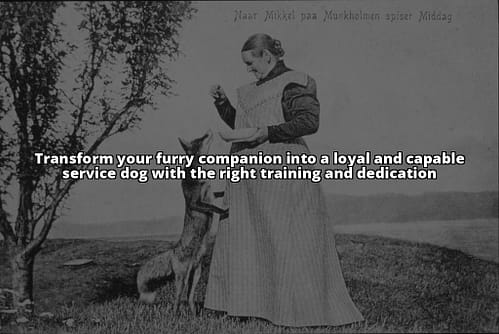Service Dog Training 101: The Definitive Guide to Making Your Dog a Service Dog
Are you interested in making your dog a service dog? Service dogs are highly trained to assist people with disabilities in various ways, such as guiding the blind, alerting their owners to an oncoming seizure, or providing balance support. In this guide, we will provide you with all the information you need to turn your furry friend into a service dog.

Is Your Dog Suitable for Service Dog Training?
The first step in making your dog a service dog is to evaluate their suitability for the job. Not all dogs are fit for service dog training, so it’s crucial to assess your dog’s temperament, health, and personality before starting the training process.
Qualities of a Suitable Service Dog
A suitable service dog should have a good temperament, be in good physical health, and be able to learn and perform tasks. Additionally, they must be friendly, calm, and able to focus on their tasks without getting distracted. They should also be comfortable in public places, as they will be working in a variety of environments.

Service Dog Training 101
- You can make your dog a service dog by determining if they have the qualities required for the job.
- There are different types of service dogs that can be trained to perform specialized tasks.
- It is important to socialize your dog, teach them basic obedience commands, and specialized tasks before registering them as a service dog.
Choosing the Type of Service Your Dog Will Provide
Once you have determined that your dog is suitable for service dog training, you need to decide what type of service they will provide. There are various types of service dogs, and each has a different set of skills and tasks they are trained to perform.
Types of Service Dogs
The most common types of service dogs include guide dogs for the blind, hearing dogs for the deaf, mobility dogs, and psychiatric service dogs.
Identifying Your Needs
To determine what type of service dog you need, you should consider your specific needs and the tasks you require assistance with. Once you have identified your needs, you can then begin training your dog to perform the necessary tasks.
Training Your Dog for Service
Training a service dog is a significant undertaking that requires a lot of time, patience, and dedication. You have two options for training your dog: self-training or hiring a professional trainer.
Self-Training vs Hiring a Professional Trainer
Self-training can be a cost-effective option, but it requires a lot of research and dedication. You will need to learn how to train your dog and how to teach them the necessary skills and tasks. Hiring a professional trainer can be expensive, but it can also be more efficient and effective.
Tips for Service Dog Training
Regardless of whether you choose to self-train or hire a professional trainer, some tips can help you succeed. First, start training your dog early, as it can take up to two years to fully train a service dog. Second, be consistent with your training and use positive reinforcement techniques to encourage good behavior. Finally, be patient and don’t get discouraged if your dog doesn’t learn a task right away.

Socializing Your Dog
Socialization is a critical component of service dog training. A well-socialized dog is more confident, less anxious, and better able to handle new situations. Additionally, a service dog must be comfortable around people, other dogs, and other animals.
Importance of Socialization
Socialization is essential because it helps your dog learn how to interact with different people and animals. This is particularly important for service dogs since they will be working with people in various situations.
Socialization Techniques
To socialize your dog, take them to different places and expose them to different people and animals. Gradually increase the level of stimulation and make sure to reward good behavior. You can also enroll your dog in a puppy socialization class or obedience class to help them learn social skills.

Teaching Basic Obedience Commands
Basic obedience commands are an essential part of service dog training. These commands are the foundation for more advanced tasks and help your dog learn how to behave in different situations.
Basic Commands Needed for Service Dogs
The basic commands needed for service dogs include sit, stay, come, down, and heel. Your dog should be able to perform these commands on command and without distractions.
Tips for Teaching Commands
To teach your dog basic commands, use positive reinforcement techniques and be consistent with your training. Start with one command at a time and gradually increase the level of difficulty. Always reward good behavior and never punish your dog for not obeying a command.
Teaching Specialized Tasks
Once your dog has mastered basic obedience commands, you can begin teaching them specialized tasks. These tasks are specific to the type of service your dog will provide and can include anything from fetching objects to providing balance support.
Examples of Specialized Tasks
Examples of specialized tasks for service dogs include opening doors, turning on lights, retrieving objects, providing balance support, and alerting their owners to an oncoming seizure.
Tips for Teaching Specialized Tasks
To teach specialized tasks, break the task down into smaller steps and use positive reinforcement to encourage good behavior. Be patient and don’t rush the training process, as it can take time for your dog to learn a new task.
| Section | Information |
|---|---|
| Teaching Specialized Tasks | |
| Examples of Specialized Tasks | Examples of specialized tasks for service dogs include opening doors, turning on lights, retrieving objects, providing balance support, and alerting their owners to an oncoming seizure. |
| Tips for Teaching Specialized Tasks | To teach specialized tasks, break the task down into smaller steps and use positive reinforcement to encourage good behavior. Be patient and don’t rush the training process, as it can take time for your dog to learn a new task. |
| Registering Your Dog as a Service Dog | |
| Legal Protection and Public Access | Registering your dog as a service dog provides legal protection under the Americans with Disabilities Act (ADA). This means that your dog is allowed to accompany you in public places, such as restaurants, stores, and public transportation. |
| Requirements for Registration | To register your dog as a service dog, you will need to provide documentation of their training and certification. You may also be required to provide proof of disability. |

Registering Your Dog as a Service Dog
Once your dog has completed their training, you can register them as a service dog. This provides legal protection and allows your dog to have public access in places where pets are not normally allowed.
Legal Protection and Public Access
Registering your dog as a service dog provides legal protection under the Americans with Disabilities Act (ADA). This means that your dog is allowed to accompany you in public places, such as restaurants, stores, and public transportation.
Requirements for Registration
To register your dog as a service dog, you will need to provide documentation of their training and certification. You may also be required to provide proof of disability.
Maintaining Your Dog’s Training and Health
Maintaining your dog’s training and health is essential for their success as a service dog. Regular training and maintenance ensure that your dog can perform tasks effectively and safely.
Importance of Regular Training and Maintenance
Regular training and maintenance help your dog stay sharp and focused on their tasks. It also helps prevent behavior problems and ensures that your dog is healthy and fit.
Tips for Maintaining Training and Health
To maintain your dog’s training and health, make sure to provide regular exercise, proper nutrition, and regular veterinary care. Continue to practice obedience commands and specialized tasks, and provide opportunities for socialization.
Educating Others About Service Dogs
Finally, it’s important to educate others about service dogs. Many people are not familiar with the role of service dogs and may not understand their importance.
Importance of Raising Awareness
Raising awareness about service dogs helps to promote understanding and acceptance. It also helps to reduce the stigma and discrimination that service dog owners may face.
Addressing Misunderstandings and Discrimination
If you encounter misunderstandings or discrimination while out with your service dog, it’s important to educate others in a calm and respectful manner. You can provide information about the role of service dogs and the legal protections they have under the ADA.
Personal Story: How My Service Dog Changed My Life
When I was diagnosed with anxiety and PTSD, my life was turned upside down. Simple tasks such as going to the grocery store or attending social events became nearly impossible for me. It wasn’t until I started researching service dogs that I realized how much they could help me.
I found a reputable trainer and began the process of training my dog, Max, as a service dog. The training process was challenging, but the benefits have been life-changing. Max has been trained to alert me when I am experiencing a panic attack and provide deep pressure therapy to help calm me down. He has also been trained to create personal space between me and others in crowded areas, which helps prevent triggering my anxiety.
Since having Max, I have been able to go places and do things that I never thought would be possible again. He has given me a new sense of freedom and independence. Additionally, having Max with me has helped reduce the stigma surrounding my mental health conditions. People are more understanding and accommodating when they see Max by my side.
I highly recommend considering training your dog as a service dog if you are struggling with a disability or mental health condition. It has been a life-changing experience for me, and I know it can be for others too.
Conclusion
In conclusion, making your dog a service dog can provide invaluable assistance to people with disabilities. By following the steps outlined in this guide, you can train your dog to become a service dog and improve your quality of life. We encourage you to do your research, be patient, and seek professional help if needed. Additionally, we suggest checking out organizations such as Canine Companions for Independence and Assistance Dogs International for additional resources and support.




Leave a Reply